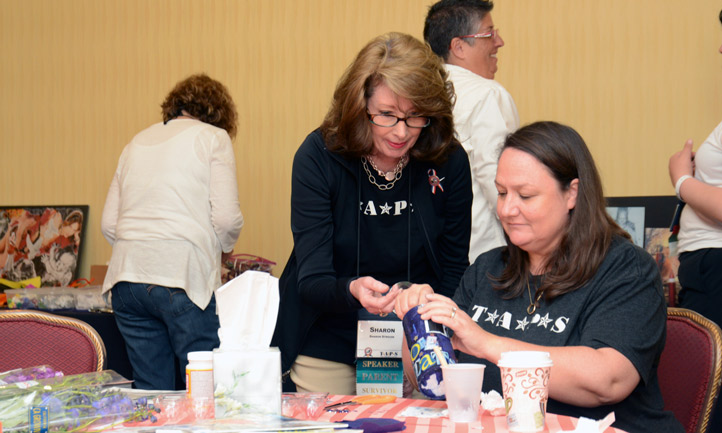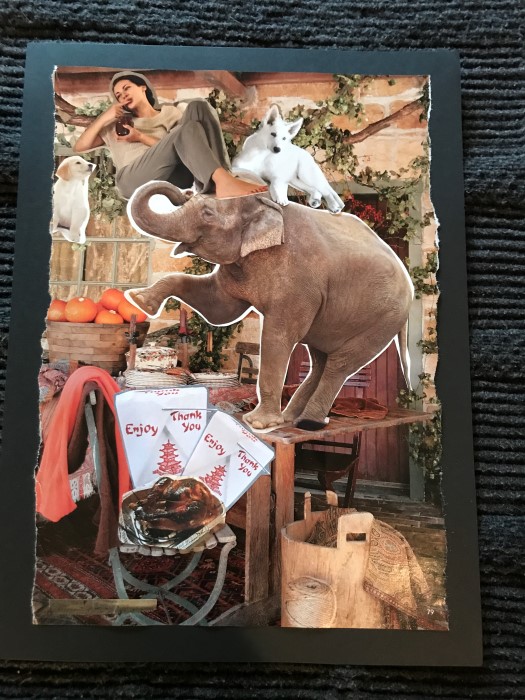Art Therapy: Expressing Grief — And Hope — Through Collages
Author: Sharon Strouse

On an exceptionally warm winter day earlier this year, I was on my way to New York. Nearly 16 years earlier, I had taken a similar train to New York’s West Side to identify my 17-year-old daughter Kristin’s body. She took her own life on October 11, 2001. That moment created a before and after and permanently altered my experience of the past, present, and future.
Integrating both Kristin’s life and death into my new inner landscape became my healing journey. It included years of meditation and self-exploration through a creative collage practice.
Now, on the train once again, I was eager to experience dreamscaping with its developer, Nancy Gershman. I’d received an invitation late last year to write a few chapters in an upcoming book, “Dreamscaping in Grief Therapy: Consolation through Prescriptive Memories.” I learned from authors Gershman and Thompson, “the dreamscaping process and product are intended to facilitate the development of internal resources and self-capacities in adults experiencing grief. Dreamscaping focuses on the sourcing of positive memories and the imagination to cultivate new ways of being with grief and loss, and commences with the creation of a dreamscape collage.” As an art therapist and surviving mother, I was intrigued by this new and innovative healing technique.
I began my dreamscaping journey aware of how important it is for clinicians to keep healing themselves. In the months that followed, my personal experience became the foundation for my dreamscape work with bereaved clients. I found its “laser like” healing quality of great benefit and was glad to add it to my grief toolbox.
As the Artful Grief Studio cleared out for lunch during the TAPS National Military Survivor Seminar in May, two women remained, huddled together at a large round table in tears and talking. I sat with the newly bereaved widows: Holly just six months out, and Claire two years down the road. They came from different parts of the country, were different ages and yet shared something profound that made them instant friends. The women talked about the holidays, specifically Thanksgiving, sharing positive memories and contrasting those with how hard it was and would be without their husbands.
Holly focused on the fear of her first Thanksgiving, celebrating in a beautiful rural yet unfamiliar location, with in-laws she was not sure could be supportive. Claire shared how stressful and awkward her first Thanksgiving was, with older relatives who were kind but reserved. “It was like an elephant was in the room. No one mentioned my husband’s name,” she said.
This was the perfect opportunity for dreamscaping; Holly and Claire could take apart these Thanksgiving scenes, literally and figuratively, and compose a new composite image and related story that was more generative. I supported and guided them as they explored some of their best Thanksgiving memories, ones that brought both laughter and tears. They each focused on the holiday and used their imagination to create an action-packed yet emotionally truthful picture of a new possibility Gershman calls “the prescriptive memory.”
 Holly began by imagining herself on the patio of her in-laws’ farm. She addressed her fear of the elephant in the room, representing her husband as an actual elephant, and thus creating a playful scenario. She reminisced about the turkey they burned on their first Thanksgiving together and the Chinese carry-out that saved the day. She inserted her two beloved dogs into the scene for support and realized how important they were to her. As a result of the brainstorming, she decided she would drive to her in-laws instead of flying, just so the three of them could be together longer.
Holly began by imagining herself on the patio of her in-laws’ farm. She addressed her fear of the elephant in the room, representing her husband as an actual elephant, and thus creating a playful scenario. She reminisced about the turkey they burned on their first Thanksgiving together and the Chinese carry-out that saved the day. She inserted her two beloved dogs into the scene for support and realized how important they were to her. As a result of the brainstorming, she decided she would drive to her in-laws instead of flying, just so the three of them could be together longer.
Claire worked with the stressful memory of her first Thanksgiving without her husband Sam and envisioned the elephant in the room as a herd of elephants making their way across the dining room table in a way no one could ignore. Further brainstorming enlivened that scene with a huge brown bear, symbolic of her husband’s love of hunting. Claire gleefully replaced the turkey with a fish; remembering the Thanksgiving they fished the morning away before joining family. She wasn’t sure how to represent herself and decided she would trust the creative process to guide her.
Holly and Claire searched through magazines as they started their collages. I reminded them to let go into their creative process and embrace the spirit rather than the letter of the prescriptive memory. “Let yourself move with the images as if you are in a dream. The idea is to awaken the emotional brain and let it speak in the language it knows best: the language of symbol, metaphor, and the senses.”
Within an hour, each had completed individual dreamscape collages. They sat quietly with their creation before sharing. Holly said, “I found a beautiful but empty patio scene and filled it with images that make me smile. I put an elephant, symbolic of my husband, right on the table, front and center. He is not forgotten. At first I put myself in a chair but re-positioned myself. I am lifted up and supported by the elephant, and that feels really good. My burnt turkey sits next to two containers of Chinese carry-out.” Holly paused to wipe away tears and said, “I just noticed the writing on the carry-out boxes – ‘Enjoy and thank you.’ I feel like Jeff is thanking me for the time we shared and giving me permission to enjoy myself.”
Claire found a Norman Rockwell print of Thanksgiving to incorporate into her dreamscape. “It feels perfect. The herd of elephants and fish came from National Geographic. When I positioned those images in the center of the table, I noticed everyone at the table was paying attention after all. As I looked at the grandparents in the picture, my heart softened in forgiveness. They came from another generation and handled loss in a very different way. I felt powerful and in control when I glued the large fish over the turkey, feeling my husband’s presence as I brought him to the holiday table. I found images of bears, each with a different feel, and settled on the bear catching the fish. I imagine Sam providing our Thanksgiving dinner. I may just bring a fish dish to Thanksgiving this year in his honor. I am not quite sure about the scuba diver, as she is clearly out of place, but she really spoke to me. We loved the water and I was reminded of that with this image. As I look at my collage, I am swimming and flowing. I feel more relaxed right now and think I will be OK after all.”
When I look at the scuba diver, I see Claire diving in and going below the surface. She has goggles to see clearly.
Holly and Claire each decided to take their dreamscapes home and put them on a shelf in their kitchens. The dreamscapes would serve as tangible reminders of the shifts in thinking and feelings over the upcoming Thanksgiving holiday. Holly created a better tomorrow and Claire created a better yesterday.
From the pen of...
Sharon Strouse immersed herself in a creative collage process a year after her 17-year-old daughter Kristin ended her own life. It became the foundation for her book, Artful Grief: A Diary of Healing. She leads national and local art therapy workshops for survivors of loss.
